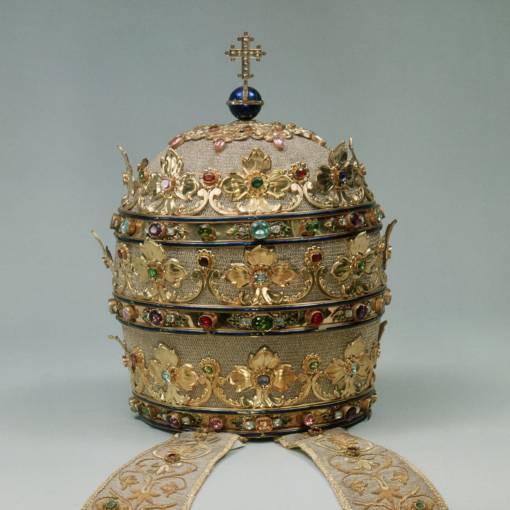This text was originally published in Polish. This is our own translation of it. We are not native speakers, so if any reader finds any errors or linguistic inaccuracies, we will be grateful for reporting them.
Die 24 decembris Anno Domini 2023 In Vigilia Nativitatis Domini
Popes are often given all kinds of gifts on various occasions, such as anniversaries, pilgrimages, audiences, important events in the life of the Church, etc. These are often beautiful and valuable liturgical paraments or utensils. They are not always used, especially on a regular basis, but many of them are sui generis works of art that are difficult to ignore, provided they can be seen at a public exhibition.
One such priceless gift is the „Franciscan” chasuble of Pope Pius XI, made in a style that attempts to evoke the Gothic. On a daily basis, it is kept in the treasury of the Apostolic Sacristy along with the other elements of the gift (stole, maniple, chalice veil, pall, bourse, corporal, purifier, Lavabo towel, alb, amice and cincture).
This chasuble appears to be a work of art worthy of special attention not only because of its craftsmanship and artistry, but also because of the theological and hagiographic message it contains. Moreover, it is an impressive and valuable monument of French liturgical paramentics of the 20th century.



Source: exhibition”Treasures of Heaven: Special Exhibition of Artifacts of the Holy See” (National Palace Museum, Taiwan 2015).

Source: exhibition „Heavenly Bodies: Fashion and the Catholic Imagination” (The Metropolitan Museum of Art, New York 2018).
The chasuble was made in 1926 by the Poor Clares from the monastery of Mazamet (Tarn department) in France and presented to the Holy Father as a gift from the Order of Friars Minor Capuchins (province of Saint Louis of Toulouse) on the occasion of the 700th anniversary of Dies Natalis (the day of death for the world and birth for Heaven) of Saint Francis of Assisi.
Pope Pius XI received the set only in 1928 during a Roman pilgrimage of the still operating organization L’Enseignement Catholique („Catholic Teaching”). Unfortunately, some parts of the vestimentarium turned out to be ill-fitting and were sent to the nuns for corrections.
The chasuble – along with the other paraments – was used by the Pope for the first time on December 20, 1928, during the Holy Mass he celebrated on the occasion of his priestly jubilee.

Source: exhibition „Treasures of Heaven: Special Exhibition of Artifacts of the Holy See” (National Palace Museum, Taiwan 2015).


Source: exhibition „Treasures of Heaven: Special Exhibition of Artifacts of the Holy See” (National Palace Museum, Taiwan 2015).
The extremely rich ornamentation of the chasuble, as well as the remaining paraments of the set, focuses on three topics: (1) the Franciscan Order (the founder, St. Clare, missionaries, martyrs), (2) Mariology (the dogma of the Immaculate Conception of the Blessed Virgin Mary is based largely on largely on Franciscan theology – the announcement of the dogma was exposed on the central part at the front of the chasuble) and (3) the papacy (Rome’s connections with the Franciscans are known, especially in the context of the influence of the sons of St. Francis on the papal liturgy, and thus on the Roman liturgy as such). Care was taken to ensure that even the pall or amice had detailed thematic ornamentations.

Source: Bernard Berthod, Chasuble et parements liturgiques pour Pie XI, „Patrimoines du Sud” 14(2021), fig. 10 (fragment) / A. Boyer reproduction © Inventaire général Région Occitanie.

Source: Bernard Berthod, Chasuble et parements liturgiques pour Pie XI, „Patrimoines du Sud” 14(2021), fig. 4 / © Sacristie pontificale (Mons. Piero Marini).
Experts in liturgical art and paramentics indicate that the seraphic symbolism used in toto may even have a dithyrambic character. All elements of the set, both in terms of meaning, artistic and historical aspects, are presented and described in detail in the study by Professor Bernard Berthod, which we provide below as recommended reading.

Source: Raymund James, The Origin and Development of Roman Liturgical Vestments, Exeter: Catholic Records Press, 1934, p. 2 / New Liturgical Movement / Hand Missal History.
It is worth noting that the „Franciscan” chasuble of Pope Pius XI was made and used by the Bishop of Rome himself at a time when the issue of the use of Gothic liturgical vestments in the Roman liturgy was quite loud in the Church – the 1920s and 1930s marked a kind of apogee of discussions on the subject..
The use of the „Franciscan” set for the papal liturgy was intentional, the Pope even gave permission to take the above photograph (some believe that due to the debate, it was slightly „improved” to make the chasuble look more voluminous).
The issue of Gothic vestments was closed (or rather „opened” for good) only by the decree of the Holy Congregation of Rites of August 20, 1957, which gave bishops the right to grant permission for the unrestricted use of Gothic vestments in their dioceses.

At the same time, it should be noted that the „Franciscan” papal chasuble of Pius XI is not made strictly according to the characteristics of the Gothic style (shape, cut, ornamentation), at most it could be considered to refer to this style in some respects. Moreover, the lower part of the chasuble has a curved shape, which was also historically found in the Roman style. Nevertheless, during the pontificate of Pius XI, and sometimes contemporaneously, the chasuble from Mazamet was attributed to the Gothic style. This claim, however, has the hallmarks of a kind of urban legend.
RECOMMENDED VIDEOS
RECOMMENDED READINGS
- Bernard Berthod, Chasuble et parements liturgiques pour Pie XI, „Patrimoines du Sud” 14(2021), https://doi.org/10.4000/pds.7024
- Nico Fassino, A Modern History of Gothic Vestments, „Hand Missal History”, handmissalhistory.com
- S. J. P. Van Dijk, J. Hazelden Walker, The Origins of the Modern Roman Liturgy. The Liturgy of the Papal Court and the Franciscan Order in the Thirteenth Century, London 1960.






